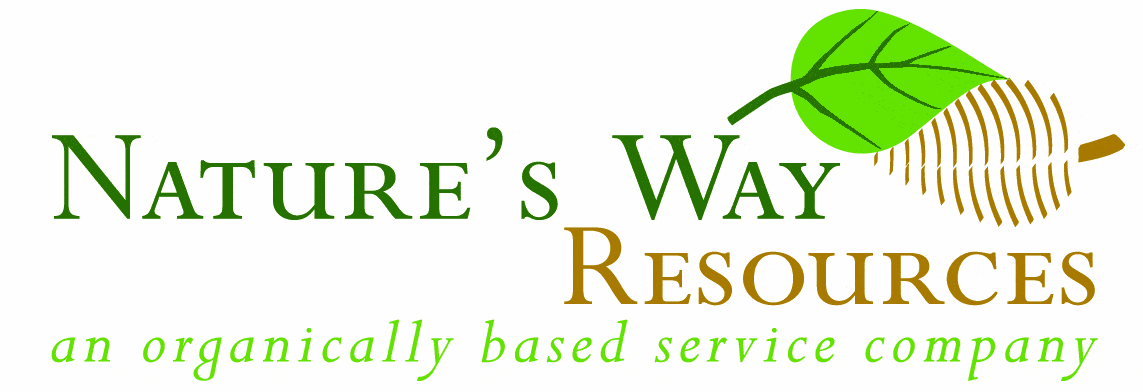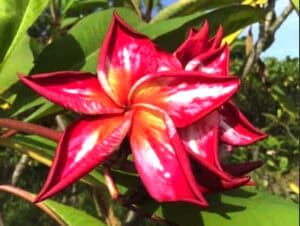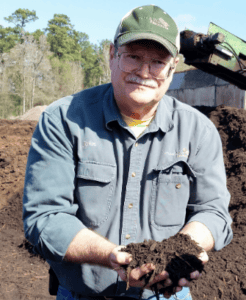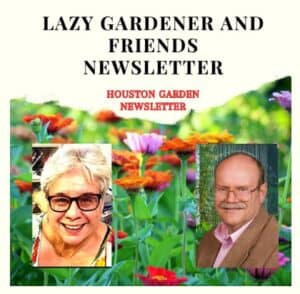 Nature’s Way Resources is proud to produce & email you this free weekly newsletter. We have no ads, but sponsors do graciously help support this project as a public service. Please note their names below & show your gratitude for this free service by patronizing their businesses! To become a sponsor, call (936) 273-1200
Nature’s Way Resources is proud to produce & email you this free weekly newsletter. We have no ads, but sponsors do graciously help support this project as a public service. Please note their names below & show your gratitude for this free service by patronizing their businesses! To become a sponsor, call (936) 273-1200
Nature’s Way Resources owner John Ferguson, “The Lazy Gardener” Brenda Beust Smith and Pablo Hernandez welcome your feedback and are so grateful to the many horticulturists who contribute their expertise
Click here to join our email list
CLICK HERE for PDFs OF PAST LG&F NEWSLETTERS
“If someone offers you advice on “Gardening in Texas,” run! They
obviously don’t understand (probably from another “smaller” state.
— Author unknown – but must know Texas!
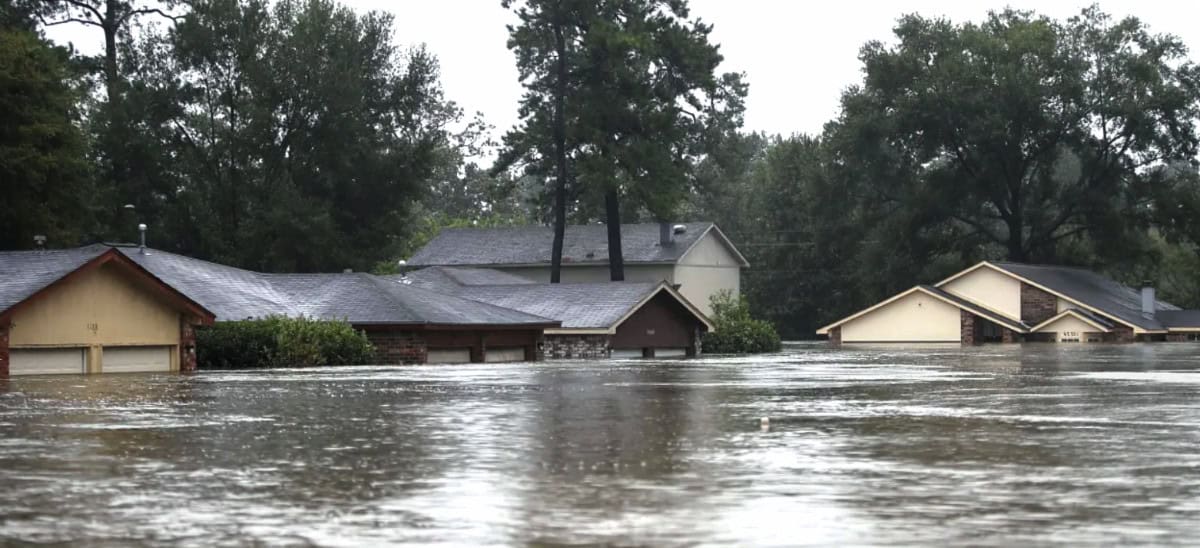
HOW CAN OUR GARDENS HELP PREVENT FLOODING?
Magnolia Multi-Service Center
Led by Robin Kendrick Yates, Master Gardener
BY BRENDA BEUST SMITH
Our potential street-flooding storms have already started. But there’s still time to sign up for Bayou Preservation Association’s free Resiliency At-Home Summer Workshop Series, which is starting with Pollinator Gardens Workshop—the first in a three-part series designed to provide Houstonians with practical protection tools for helping homes and communities to avoid repeats of our flood damages.
Secret to success: learn to create a vibrant, pollinator-friendly garden while supporting our bayous’s health. This workshop will emphasize the crucial role pollinators play in biodiversity, food systems, and ecological resilience.
If your visions are of previously-dug massive flood “ponds,” they often didn’t work (obviously). Focus now is on public greenspace with 100 million gallon-holding nature preserves, designed to slow water flow to, hopefully eliminate water surges hitting the local bayous and our homes.
A new-thinking experiment in Clear Lake (badly flooded before) is credited with stopping flooding of 150+ homes in Hurricane Harvey. What does all this have to do with your yard? Projection of saved homes with this approach: 2,000!
EPA’s Green Infrastructure uses or mimics nature to slow down, absorb and filter rainwater where it falls. We can’t control how much rain falls during hurricanes and other threatening weather. But we can make sure our yards and gardens will absorb as much rainfall as possible.
Here are some more “gardening-related” suggestions from Bayou Preservation Association’s Program Manager, MORTON SAGER on gardening and its benefits for our bayous and local waterways.
Tips for Creating a
Bayou-Friendly Native Garden
by MORTON SAGER
BPA Program manager
- Start by examining your property for invasive plants.
One major offender is privet (Ligustrum spp.), a popular landscaping shrub often used by homebuilders. Birds consume its berries and disperse the seeds into nearby natural areas, where privet creates dense thickets that crowd out native vegetation and disrupt ecosystems. Along our bayous, privet replaces important native plants that stabilize banks and filter runoff, increasing erosion and nutrient pollution.
- Be Cautious with Lantanas
Lantanas are showy and resilient garden plants, yet many varieties available in Houston are non-native and invasive. Specifically, Lantana camara easily escapes cultivation and overtakes natural areas, especially along bayous and floodplains. Seek out true native Texas lantana species, such as Lantana urticoides, to enjoy pollinator-friendly color without harming native plant communities.
- Double-Check Plant Labels
Garden centers sometimes mislabel plants as “native” when they aren’t. Use free plant ID apps like iNaturalist or PlantNet to verify what you’re purchasing. A common example is Tropical Milkweed (Asclepias curassavica), often sold as a native milkweed for Monarch butterflies. Although it is a milkweed species, it isn’t native to Texas and can disrupt Monarch migration, contribute to disease spread, and prevent butterflies from completing their journey to Mexico.
- Consider Bloom Times and Seed Production
Planting a variety of native species with staggered bloom periods creates a dynamic, colorful garden that continuously provides food for pollinators. Allow spent blooms to remain until the seeds are fully mature, many native plants, particularly those adapted to our prairies and bayou corridors, require time to set viable seeds and depend on wind or animal dispersal.
- Create a Bioswale or Rain Garden
Transform low or wet areas in your yard into a bioswale or rain garden using native grasses and perennials. These features slow stormwater runoff, filter pollutants, and provide habitat for birds and pollinators. They also lessen the burden on storm drains and protect nearby bayous from erosion and sediment overload.
- Be Patient: The “Three-Year Rule”
Native plant gardens don’t always look perfect in their first year. There’s a saying: First year they sleep (develop roots), second year they creep (grow foliage), and third year they leap (take off).
Healthy, mature native plantings enhance stormwater absorption, reduce soil erosion, and prevent runoff pollution, which are essential functions for maintaining clean, resilient bayous.
Good Native Plant Resources:
- City of Houston Invasive Plants List: https://link.edgepilot.com/s/346dea5f/y8S9lVPLeEmuVM7owBD2QA?u=https://houstontx.gov/parks/pdfs/2010/HPARDInvasivePlants.pdf
- Native Plant Society of Texas
- Texas Master Naturalist
(For specific nursery, check the BPA’s website above)
By thoughtfully selecting and managing native plants, home gardeners can reduce the spread of invasive species, enhance stormwater management, and support local pollinators, all of which contribute to protecting the natural systems that keep our bayous healthy.
REMEMBER TO SIGN UP FOR Bayou Preservation’s Resiliency At-Home Summer Workshop Series: Pollinator Gardens
Brilliant Star plumeria flaunts large, 4-inch star-shaped
petals, each pointed/painted with striking red & white spotted pattern.
Mike Kennedy photo
GREMLINS INVADED and :poof!” half of Plumeria Society of America’s article last week vanished before publication. Given all the Hurricanes warnings lately, this PSA advice makes sense!
With July temps now frequently hitting triple digits—and storms packing fiercer winds—many longtime plumeria growers are adjusting both strategy and structure.
1. Rethink Pot Placement
Plumerias planted in raised containers? Not anymore. More members are opting to sink containers halfway into the ground during the heat of summer. This buffers root zones from radiant heat while allowing for easy winter lift-and-store.
2. Cooling the Roots
In-ground plants benefit from a deep mulch layer (2–4 inches) to moderate soil temperature. Topping your plumerias with mulch or compost will keep plants from experiencing heat stress during our hottest weather.
3. Timing Your Water
Avoid midday watering, which can steam roots in their pots. The best time? Early morning when evaporation is lower and plants can hydrate before the heat peaks. Foliar sprays with kelp or seaweed extract can help reduce transplant and heat shock during active growth.
A Resilient Favorite
Despite the climate curveballs, plumeria remains one of the most forgiving and rewarding tropicals in our region. With a few tweaks—and perhaps a new variety or two in the mix—Houston-area gardeners can continue enjoying vibrant blooms deep into fall.
Have a favorite heat-hardy plumeria? Share it with your local garden club or society—you might just help create the next Gulf Coast classic.

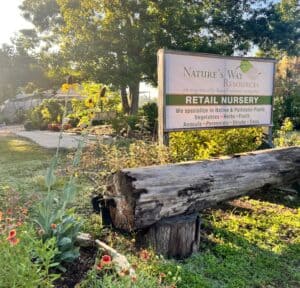 ATTN. GARDEN/PLANT GROUPS — Nature’s Way Resources offers free guided tours of NWR’s extensive nursery/soil/mulch facilities for garden clubs, plant societies and other plant-oriented, organized groups. As usual, NWR’s now-expanded meeting site is free to above groups. Reservations a must for both. Great time to visit!
ATTN. GARDEN/PLANT GROUPS — Nature’s Way Resources offers free guided tours of NWR’s extensive nursery/soil/mulch facilities for garden clubs, plant societies and other plant-oriented, organized groups. As usual, NWR’s now-expanded meeting site is free to above groups. Reservations a must for both. Great time to visit!
- SUBMITTING CALENDAR EVENTS?: For next upcoming newsletter, submit in exact format (see top of calendar below. Reformatting = delay)
John’s Corner
NEWS FROM THE WONDERFUL WORLD
OF SOIL AND PLANTS
Subject: Book Review
I read a new book this past weekend that was just released and is written to help the average gardener rebuild their gardens into more environmentally friendly and sustainable places.
GRASS ISN”T GREENER – The Everyday Conservation’s Guide to Bringing Nature to Your Yard, Danae Wolf, Timber Press, 2025, ISBN: 978-1-64326-329-8
This book is about building ecological function rather than traditional gardening which focused on beauty that only appeals to humans at the cost of destroying God’s creation.
We now know that all life is connected from the smallest bacteria to the largest trees, from the health of the soil to human health, from the health of the plants to the health of birds and animals. We are all connected.
It is well known that the toxic chemical rescue methods I was taught in college are directly behind many environmental problems from climate change to species loss, to the extremely poor quality of our food, to most of our health problems.
This book is about how an average gardener can make some small changes and be part of the solution.
Chapter one starts off talking about understanding our land. This ranges from what the soil is, to the local climate to even the topography of the land. The author then proceeds to reducing the size of our lawns, which are a major source of environmental abuse. She explores some of the alternatives to grass and how to get rid of it.
She proceeds to discuss the advantages of native plants and the eco system services they provide. Throughout the book she uses lots of beautiful photographs to help illustrate the different ideas.
Next, she discusses invasives and how they hurt the eco-system along with pictures of a few. She smoothly moves into the purpose of leaves in nature and from there into mulching.
From these basics she explores how to have a pollinator garden that is bird friendly. She even touches on how light pollution is killing millions of birds each year. She explores several other beneficial gardening ideas and how to implement them.
A chapter I liked was how to incorporate edibles into one’s garden followed by compost and some soil improvement tips. She then wraps up the book with some ideas on how to enjoy one’s garden.
From the publisher:
Built around easy-to-digest tips for improving sustainability, this fun, action-oriented guide will help everyone turn their home garden into an earth-friendly habitat.
Rooted in twenty practical steps that anyone can take starting today, Grass Isn’t Greener demonstrates how small changes in your yard or garden can create lasting impact for the planet: from leaving your leaves to selecting eco-friendly holiday decorations; from eliminating light pollution to attracting wildlife; from saving seeds to devoting even a small patch of lawn to native plants. With easy-to-follow advice and real-life examples, conservation educator Danae Wolfe will help you appreciate the new life you’ve attracted to your yard. A companion for new homeowners, renters, and gardeners, Grass Isn’t Greener is a resource for anyone looking for little ways to make a big difference—and to have fun doing it.
SPONSORSHIP
If you are interested in becoming a sponsor, please contact us at 936-273-1200 or send an e-mail to: lazygardenerandfriends@gmail.com
ABOUT US
BRENDA BEUST SMITH
WE KNOW HER BEST AS THE LAZY GARDENER . . .
but Brenda Beust Smith is also:
- a national award-winning writer & editor
- a nationally-published writer & photographer
- a national horticultural speaker
- a former Houston Chronicle reporter
When the Chronicle discontinued Brenda’s 45-year-old Lazy Gardener” print column — started in the early ’70s as a fun side-project to reporting, it then ranked as the longestrunning, continuously-published local newspaper column in the Greater Houston area. The name, she says, is not just fun, it’s true.
Brenda’s gradual sideways step from reporter into gardening writing led first to an 18-year series of when-to-do-what Lazy Gardener Calendars, then to her Lazy Gardener’s Guide book which morphed into her Lazy Gardener’s Guide on CD, which she now emails free upon request.
Brenda became a Harris County Master Gardener and, over the years, served on theboards of many Greater Houston area horticulture organizations. She hosted local radio and TV shows, most notably a 10+-year Lazy Gardener specialty shows on HoustonPBS (Ch. 8) and her call-in “EcoGardening” show on KPFT-FM.
For over three decades, Brenda served as Assistant Production Manager of the GARDEN CLUB OF AMERICA’S “BULLETIN” magazine. Although still an active broad-based freelance writer, Brenda’s main focus now is THE LAZY GARDENER & FRIENDS HOUSTON GARDEN NEWSLETTER with John Ferguson and Pablo Hernandez of Nature’s Way Resources.
A native of New Orleans and graduate of St. Agnes Academy and the University of Houston, Brenda lives in Humble, TX, and is married to the retired Aldine High School Coach Bill Smith. They have one son, Blake.
Regarding this newsletter, Brenda is the lead writer, originator of it and the daily inspiration for it. We so appreciate the way she has made gardening such a fun way to celebrate life together for such a long time.
About her column, Brenda says: “I don’t consider myself a ‘garden writer.” I started out 50+ years ago as a very lazy “gardening reporter.” I still feel that way today. I hope my columns inspire/help newcomers, but I do not write to them. I write to very experienced gardeners who want to expand their horizons.
JOHN FERGUSON
John is a native Houstonian and has over 35 years of business experience. He owns Nature’s Way Resources, a composting company that specializes in high quality compost, mulch, and soil mixes. He holds a MS degree in Physics and Geology and is a licensed Soil Scientist in Texas.
John has won many awards in horticulture and environmental issues. For years he represented the composting industry on the Houston-Galveston Area Council for solid waste. His personal garden has been featured in several horticultural books and “Better Homes and Gardens” magazine. His business has been recognized in the Wall Street Journal for the quality and value of their products. He is a member of the Physics Honor Society and many other professional societies. John is the co-author of the book Organic Management for the Professional.
For this newsletter, John contributes articles regularly and is responsible for publishing it.
PABLO HERNANDEZ Pablo Hernandez is the special projects coordinator for Nature’s Way Resources. His realm of responsibilities include: serving as a webmaster, IT support, technical problem solving/troubleshooting, metrics management and quality control. Pablo helps this newsletter happen from a technical support standpoint.
Download the Newsletter with Our Events Calendar Below!
